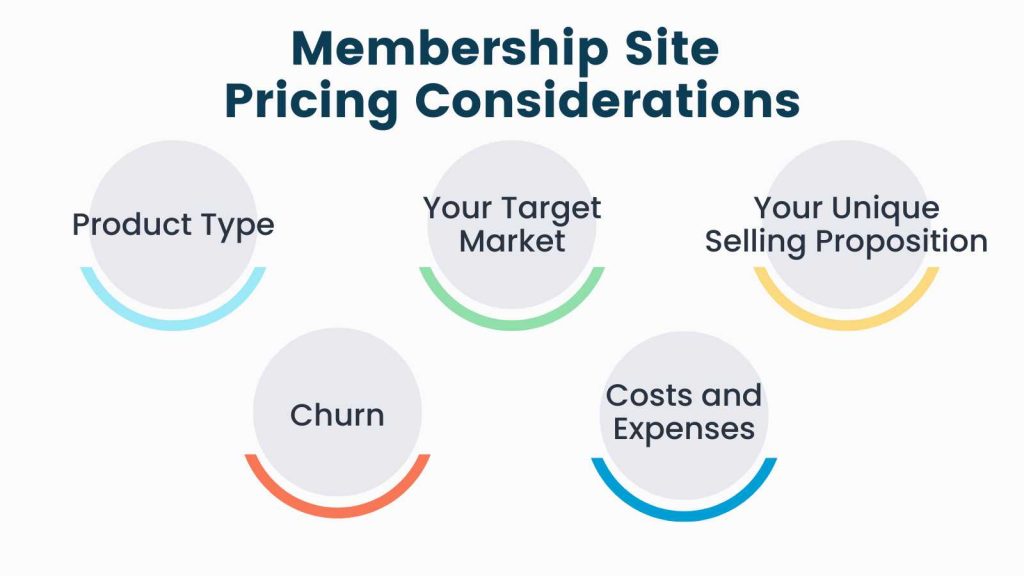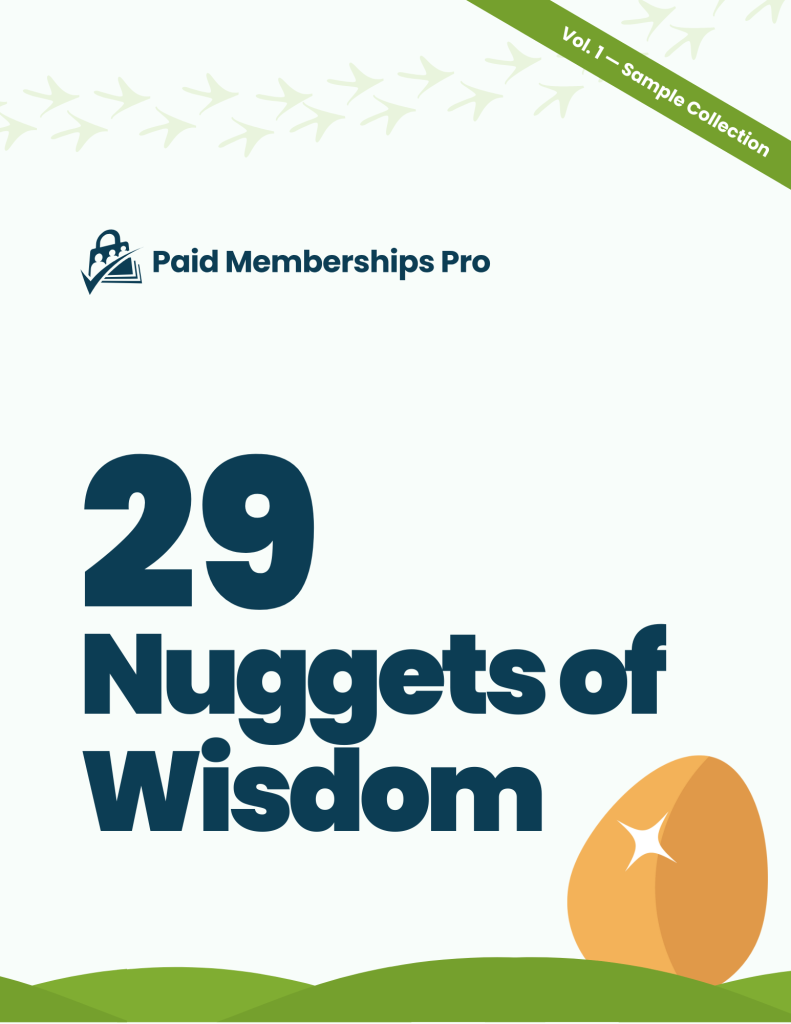Knowing how to price a membership site is essential if you want to run a successful membership site.
Before launching your membership site, it’s important to think about all of the different factors you need to consider in your pricing strategy. This will help you make informed decisions about your membership prices, appeal to your ideal customer, and remain profitable over time.
Even after launching, you should revisit your pricing strategy every 6-12 months.
If you get your pricing right, chances are people will be willing to pay for your membership and remain loyal for the long term. So, let’s talk about how to price a membership site.

Some Basic Rules
First, here are a few rules/guidelines that are always useful no matter what stage you are at with your membership site.
- Just sell already. Don’t let price worries keep you from selling your product as soon as possible. If you think your product is worth $100/month, but you’re worried that might be too high a price, start selling already and find out for sure.
- Go with your gut. You probably already have an idea of a price in your head. Don’t be afraid to go with your gut on it. If the price “feels right” to you, it will probably “feel right” to your customers too.
- Keep it simple, especially in the beginning. Complex pricing schemes can distract you from more productive work and can make it harder to change your pricing when you need to be feeling things out. Which brings us to…
- You can change your price later. Don’t feel locked into whatever pricing decision you make at the outset. You can change your price later. We have a post all about the do’s and don’ts of raising prices.
Video: How much should you charge for your membership site?
Considerations When Pricing a Membership Site
There are some standard factors to consider when determining your membership pricing. But it’s important to remember that what works for one business might not work for another.
Even if you run multiple similar membership sites, it’s still necessary to review certain criteria with any individual site before you set your prices.
Product Type
First, determine the kind of product you’re going to create for your membership business. Is this product something you want to present as a “good deal” to your customers? Or do you want to sell a premium offer?
Understanding the value you want to give your subscribers will help you figure out what to charge.
Your Target Market
Similarly, it’s crucial to understand the market that you want to enter. Do some research to see what your competitors are charging for their memberships. This will give you a general idea of what your target audience is willing to pay.
Your Unique Selling Proposition (USP)

And while you look at your competitors, think about what they’re offering. Is there something you can provide your subscribers that they can’t get anywhere else? If there is something your competitors aren’t doing, there’s an opportunity for you.
Think about how your membership is unique, or how you can make your offer unique in order to attract customers.
You can determine how to position your membership on the market by distinguishing the unique value you provide.
Churn
Don’t forget to factor in member churn. Theoretically, members should stick with you. But, the reality is that some will decide to leave, and you’ll need to account for them when setting your prices.
If you’re not already familiar, churn rate is the percentage of customers that leave during a given subscription period. For example, you could calculate your monthly churn rate by examining how many people abandon your membership each month.
It’s difficult to know the churn rate you should expect without having any data to review, but the average membership-based website experiences a 6.7% churn rate annually. When pricing your membership, take this number into account.
Costs and Expenses
One of the most basic things to consider when it comes to pricing a membership site is your costs and expenses. These include things like your domain, web hosting, software, security, other tools or maintenance, and any outside help that you hire.
WordPress free content management system (CMS), so if you choose this option, you’ll only have to pay for hosting, as well as any plugins you need for your membership.
To keep your membership business profitable, your revenue should always cover all of your expenses—at the minimum.

Membership Pricing Models
There are many membership pricing models to choose from. The key is to find one that works for you and the specific needs and requirements of your business. Read our guide on the 10 most popular membership pricing models, which will help you decide between fixed term pricing, recurring subscriptions, front-loaded plans, installment plans, lifetime plans, trials, freemium pricing, and more.
How to Price a Membership Site
There is no one-size-fits-all method for how to price a membership site. There are dozens of methods and strategies people use to figure out what how much to charge. Most of them are good and useful.
Rather than pick one strategy, we suggest running through every method you can find. With each pricing exercise you complete, you will learn more about what matters to you and your customers. You will notice the same general price ranges coming up over and over again, giving you the confidence you need to choose a price and get it live for testing.
To that end, here are some pricing exercises to go through.
Exercise 1: How much do you want to make?
Think about how much money you need to make for your membership to be a financial success. Go ahead. Really do it.
If your answer is “a billion dollars” or “as much as possible”, pick a shorter term goal to get going. Be honest with yourself, and pick a number that cover all of your expenses and make it worth your time to keep working on your site.
Once you’ve figured out how much you want to make, you can back out from there how many members you would need at different price points to meet your goal. Write out a few options to see which feels best to you based on the size of your market, the amount of value you can provide your members, and your ability to connect and sell to those members.
Here’s a table with a few different ways to make $120,000 per year.
| Members | Price | Total | Notes |
|---|---|---|---|
| 1000 | $10/mo | $120k | Can you find and convert 1000 paying members? |
| 200 | $50/mo | $120k | $50/mo is common price for a subscription members get value from every month. |
| 2000 | $60/year | $120k | Annual pricing is often better for memberships with lower engagement spread out over time. |
| 240 | $500/year | $120k | What are customer expectations for a $500/year membership vs a $60/year one? |
Remember, doing this exercise is more about what you learn than the actual numbers you get. You don’t want to just use these rates without further thinking. How many members do you need to have to reach your goals? Is it more than you thought? Can you sell fewer memberships at a higher price? What may have to change about your membership to justify that higher price?
Exercise 2: Time and Materials x Margin
Figure out what it costs you to offer and support your membership and then add a nice margin on top for your value.
Consider the potential “unit costs” for each membership sold.
- 3-5% processing fees.
- Up to 10% sales tax.
- Platform fees.
- Incremental support costs.
- Physical goods and shipping.
- Advertising/affiliate fees. (Acquisition costs.)
If it costs you an average of $50 to get a new member and serve them, then that is the minimum you need to charge to break even. But you want to make a profit, and you likely have other regular business expenses you need to cover. So multiple that $50 by 2 or 3 or 4 to get the price you will charge your members. If you charge $200, that gives you $150 of “margin”. The more margin you have baked into your pricing, the more flexibility you will have with running sales and experimenting with new sales channels that might have higher costs.
Again, by itself this is not the best method for coming up with the price for your membership. However, when combined with other methods that take into account customer expectations, figuring our your time and materials cost will let you know if your pricing is reasonable for your business. Most importantly, figuring out the cost of each member will tell you the minimum you need to charge to make a profit.
Exercise 3: What’s the value of a membership to your customers?
It’s generally understood that in B2B businesses there are two ways to get your customers to fork over their hard earned money: you either save them time or money. Because time is money, we’re really just talking about saving them money. And so…
The value of your membership product will be equal to the amount of money it helps your customers save or earn.
If you can convince your customers that purchasing your membership product will save them more money than it costs, getting them to checkout is just a formality.
Does your membership save your customers money? How much? Put a specific dollar amount on it. Does your membership save your customers time? How much? Put a specific dollar amount on it.
Related: Jason Coleman was interviewed on the Art of Value Podcast. Check it out for a detailed discussion on value pricing for membership sites.
If you find this exercise too difficult, talk to your customers some more. Ask them about the alternatives they’ve thought about, and find out what those alternatives cost. Ask them how much time your membership is saving them and multiply that by some hourly rate appropriate for them.
The idea here is to think about your customers and how they will value your membership products. Knowing how your membership will be valued will tell you if you are charging too much or too little and will also provide bullet points to help your marketing.
Video: 6 Ways to Price a Membership Site
Ready to Build Your Membership Website?
Are you ready to create a consistent income stream with memberships? It’s as easy as installing Paid Memberships Pro on your WordPress site.
Paid Memberships Pro has different plans and pricing to fit all membership sites, and more complete features than other membership plugins. Install Paid Memberships Pro today and start building your dream membership site for free.


